On our third day in Romania we started a 2-day trip to Transylvania, in the northern part of the country. We reserved the first day to visit Sibiu. The city was the European Cultural Capital for 2007. Between 1692 and 1791 as well as 1849-1865, Sibiu was the capital of the Principality of Transylvania. Its first mention comes in an official papal record from 1191 as the headquarters for an independent German settlement. The 14th century finds Sibiu as a key trade centre, with 19 craftsmen guilds. It was a major ethnic German city in Transylvania before the 18th and 19th century, when it became the most important centre for Romanian ethnics.
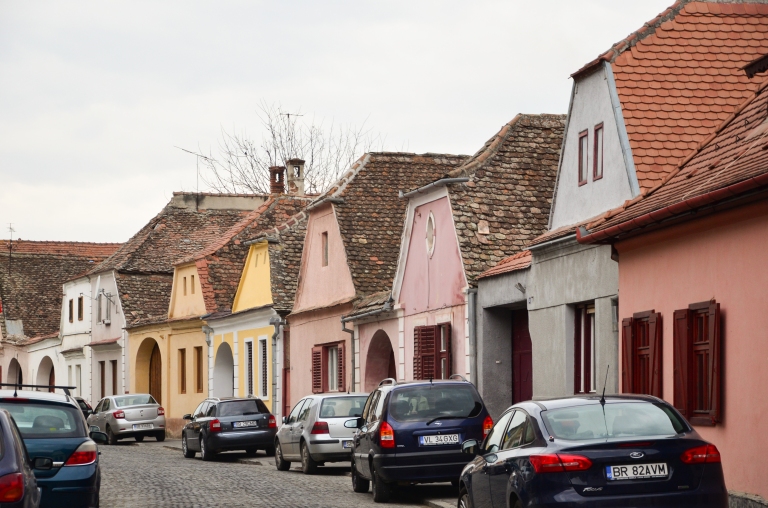
We arrived at the guesthouse, on a winding but quite wide medieval street, in the Lower Town of Sibiu. Traditionally, the Lower Town, between the Cibin River and the hill, was the home of the manufacturing industry, with the long streets cut by small city squares. Our courtyard vernacular guesthouse is typical for the area, as we discovered by looking up the solids and voids on Google Maps. The buildings are usually two-storey houses with tall roofs, arranged around private inner courts accessed through high gates and passages from the streets.

Making our way towards the centre, we passed under the Liar’s Bridge, the first iron cast bridge in Romania built in 1859. This passage is the main access point from the Lower Town to the Upper Town of Sibiu, which was known as the wealthier, commercial area. The Upper Town is organised around three squares at the top of the hill, one of which is where we found ourselves now: the Small Square, surrounded by small pubs, cafes and boutique shops. The atmosphere of the place was slightly confusing, as the main passageway, open to traffic, was dividing the square into two areas, both taken over by cars.
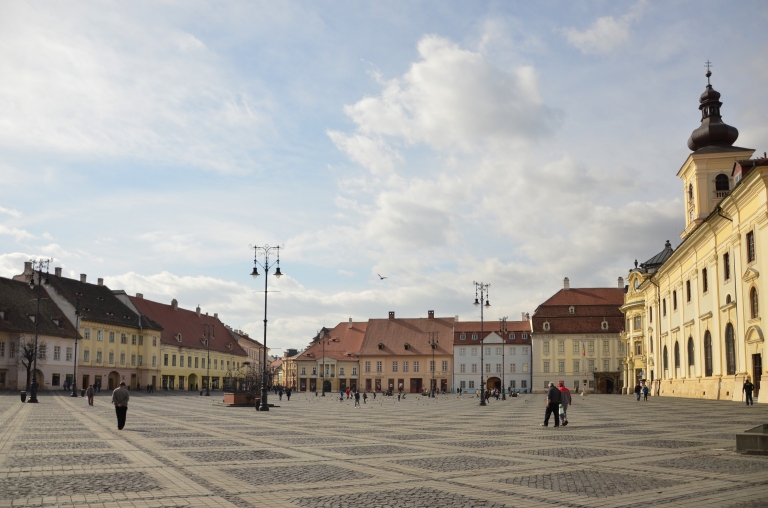
We continued towards the Grand Square going under the 13th century Council Tower. The square is a vast space that is surrounded by major landmarks such as the Baroque Brukenthal Palace and the Art Nouveau building which houses the Mayor’s office and Info Centre. Here we came across a small exhibition organised by the Architecture students of the Spiru Haret University on 20th century architectural heritage. There was a section on house typologies in the region and another on architect Horia Maicu, who’s work moved from streamlined private residences on the seaside in the 1930s, to reshaping Bucharest in a Moscow style, with Soviet Socialist Realism architecture. A couple of his well-known buildings are the Free Press Building and the National Theatre. His contrasting architecture speaks of two distinct eras of Romanian history: the inter-war, European, outward-looking period, and the Communist era, caught in the shadow of Stalin. Although the subject matter of the exhibition was very promising, its design was disappointing, with questionable board composition and bad use of font, which made it hard to read.
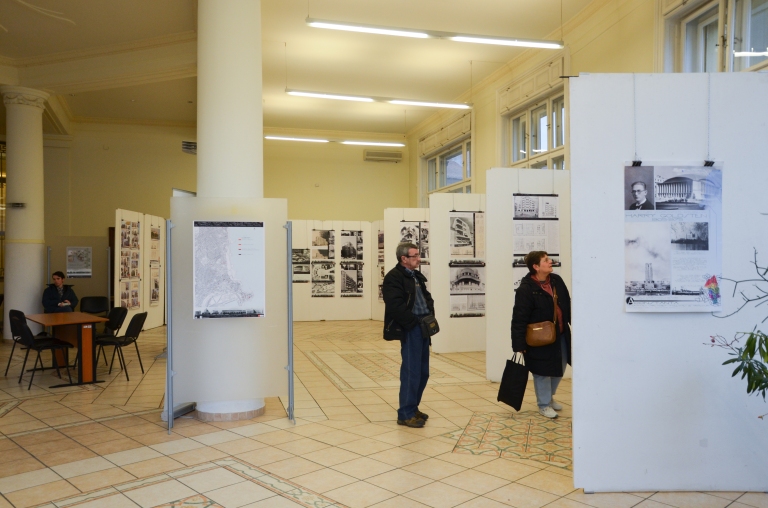
The most distinguishable feature of the square is the different forms and colours of the row of buildings surrounding the wide space. These old houses, some dating back from the 15th century, are in Renaissance or Baroque styles, and are known the “city’s eyes” for their small attic windows. We think these architectural elements give the buildings a sort of human character and personality, and a vigorous presence in the square. We wonder if the “eyes” would act as an architectural crime deterrent, making misbehavers more conscious of their actions as they would feel as they were being watched, and thus giving a sense of order and security to the space. Nonetheless, the square felt very airy and bright also because of the small scale of the buildings and the tall attics.

Huet Square, our next destination, has the Evangelical Lutheran Cathedral, in Gothic style, at its centre. Here we sat for a coffee at Wien Café, which overlooks the Lower Town, to do a few sketches. From here, we went along the Passage of the Stairs, which goes under some support arches of the fortifications, linking the two sides of the city.
Around the city centre, we noticed the high amount of educational institutions and cultural centres aimed at the German population. After the fall of the Austro-Hungarian empire at the end of World War 1, Sibiu became part of Romania, but the majority of its population was still of Saxon origin. However, they city’s German ethnics began to emigrate to Germany and Austria in the second half of the 20th century, whilst there was a steady rise of the numbers of Romanians moving into the city. The most abrupt change in demographics, however, occurred after the 1989 Revolution, when the number of ethnic Germans dropped to 5,000, with less than 2,000 remaining at the moment, which is why we found some of the historical architecture fallen into a state of disrepair. This demographic trend is obvious when we look at Religious denominations in the city as well. 100 years ago, there was a balanced pluralism of religions, with Lutheran, Eastern Orthodox, Catholic and Jewish being highly represented. Currently, a huge 91% of the population is Orthodox Christian, a worrying phenomenon that is visible throughout the country.
To an extent, however, the Saxon culture and lifestyle in Sibiu is still quite obvious, especially on the background of German architecture. This was around mid-day on an undistinguishable Tuesday when we strolled along the pedestrian Nicolae Balcescu Street. The ground floor of each of the row buildings was taken over by a different use: from banks, to convenience stores, bars, cafes, law offices, restaurants, galleries, public institutions and clothes shops. Some restaurants spilled out on the street, and we imagined the street being filled with tables and chairs in summer time. Visiting in winter gave us a more authentic feel of the place however; the lack of tourists did not take away from the buzz of the city centre. There were families slowly walking along, groups of youngsters sitting on benches laughing, workers going about their business at a casual pace, old ladies and men stopping for short philosophical conversations about the old days or looking up at the signs on the buildings and stopping to ponder. The general pace was casual but lively, and the speeches were slow and with a friendly tone, typical of the Transylvania region. There were queues for the pretzel shops everywhere, and we couldn’t resist not indulging in this German-influenced tradition of having a baked snack between meals.
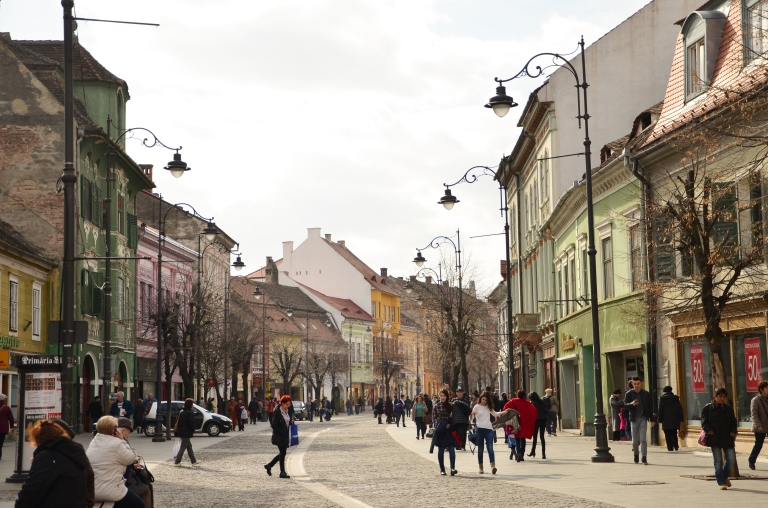
One negative aspect of the square, which we noticed around the centre as well, was the ubiquity of oversized, brightly coloured and sometimes brightly lit logos and company signs on the historical buildings. There seemed to be very little coherence between company names and logos, awful extensions into the street, or badly replaced double-glazed windows. We subsequently learned that there is a small battle being fought by the Council against the owners and tenants of heritage buildings, but with very few positive results. There clearly needs to be a change in approach regarding these architectural jewels of the city.
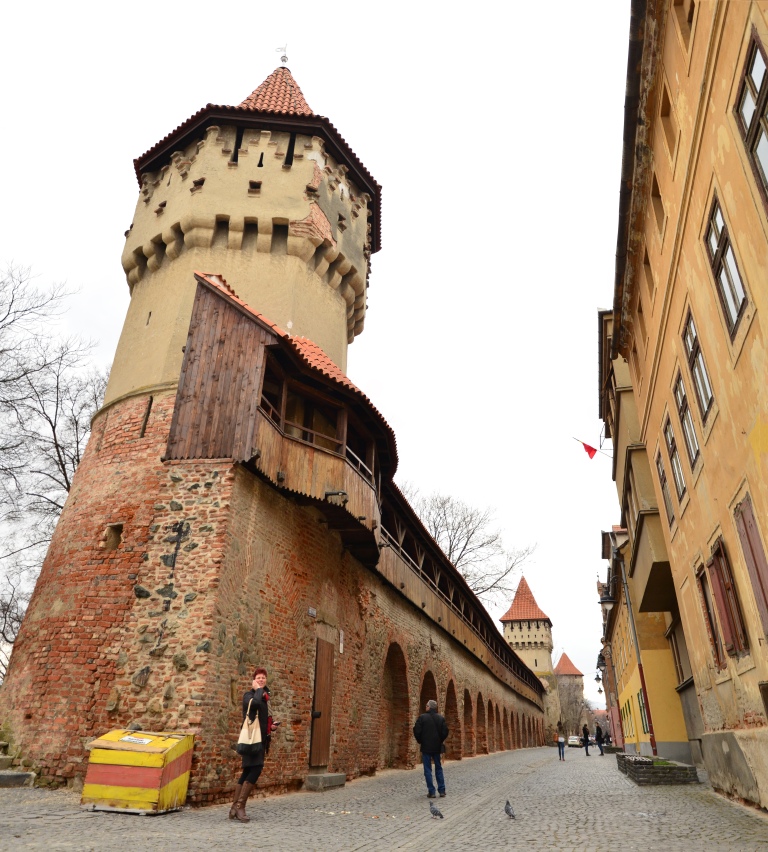
After eating at a restaurant on the main pedestrian street, we decided to head for a café and pub tour of Sibiu. Unfortunately, a lot of places were closed, probably because the weather was still chilly. We first had a coffee at Café Einstein in the Small Square. As we were passing the Council Tower, we realised it was still open so we decided to go up to the top. The view wasn’t much, at it was dark by now, but we enjoyed the stripped down interior of the tower and the 1494 clock mechanism, still in use. We also had a quick look in the Humanitas bookshop just before it was closing. Although not looking like much at street level, we discovered the underground level, organised around original cellar brick arches, with a small café and a concrete bar.
Attracted by the light coming on to the Nicolae Balcescu Street, we then went into La Etaj (meaning “upstairs”), a cocktail bar opened in one of Baron Brukenthal’s houses. We chose to sit in a separate room that had a long thick timber table with a slit in the middle for grass to grow. We enjoyed the rest of the contemporary interior design as well, with a huge stand-alone lamp, a blue bookcase and transparent chairs. We decided to end the night at a cavernous bar from the Large Square called Art Café. In the small underground spaces where it was clear that we were the only people there without a cigarette in hand, we discussed what will happen to the drinking and eating establishments of Romania when the smoking ban will start being reinforced in a month.









I had had absolutely great times there, thanks for nice memories!
LikeLike
No worries, thanks for reading!
LikeLike
This is very beautiful and colourful
LikeLike
Thank you, we’re glad you like it
LikeLiked by 1 person
Yeah i love this kind of stuff. Thanks for sharing 🙂
LikeLike
Check out my blog when you get the chance.
LikeLike
Fantastic post!! I will absolutely be visiting when I am over in Romania volunteering this summer!
-Katrina
LikeLike
Thanks! Yes in summer the city becomes even more lively, you should definitely spend some time there!
LikeLiked by 1 person
Probably meaningless to you but in Romanian:
“La etaj”- Upstairs
“Parter”- First (ground) floor
LikeLike
Hey! Yes thanks for the correction, that’s a better translation!
LikeLike